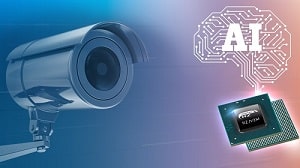- Renesas’ series of MPUs that offer power efficiency in embedded systems for AI and reduces BOM
- Optimal for industrial and retail surveillance systems
 Renesas Electronics, a supplier of advanced semiconductor solutions, has introduced the RZ/V series of microprocessors (MPUs), which features DRP-AI (Dynamically Reconfigurable Processor) and vision-optimized artificial intelligence (AI) accelerator. The first product in the series, the RZ/V2M, is designed to deliver a combination of real-time AI inference and power efficiency in embedded devices.
Renesas Electronics, a supplier of advanced semiconductor solutions, has introduced the RZ/V series of microprocessors (MPUs), which features DRP-AI (Dynamically Reconfigurable Processor) and vision-optimized artificial intelligence (AI) accelerator. The first product in the series, the RZ/V2M, is designed to deliver a combination of real-time AI inference and power efficiency in embedded devices.
The demand to have real-time, AI-based person and object recognition functionality in applications such as surveillance cameras for industrial and public infrastructures as well as product scanners and POS terminal cameras has been growing rapidly. However, the higher power consumption and heat generation required for AI processing is introducing new challenges for embedded developers. The RZ/V2M leverages the DRP-AI’s excellent power efficiency to bring down power consumption to as low as 4W. This eliminates the need for heat sinks and cooling fans, greatly simplifying heat dissipation measures. This also enables RZ/V2M to be used in compact devices or help minimize equipment sizes, expanding the opportunities to incorporate AI in embedded devices. It also helps to reduce bill-of-materials (BOM) costs.
Powerful imaging capability
Besides the DRP-AI, the RZ/V2M features an imaging signal processor (ISP) capable of processing high-resolution 4K pixels at 30 frames per second. The ISP employs high dynamic range (HDR) functionality capable of handling images with large differences between brightness and darkness, noise reduction functionality and distortion correction functionality to substantially boost precision in AI recognition. This ensures the ability to produce clear images regardless of factors such as the weather, the time of day and the installation location. With these integrated features, the RZ/V2M delivers a major innovation capable of bringing highly accurate AI and low power consumption to a wide range of embedded devices.
The DRP-AI vision-optimized AI accelerator is an intellectual property (IP) evolved from the DRP built into the RZ/A2M, designed for tasks such as reading 2D barcodes and iris recognition. To magnify operation processing capabilities, the DRP functionality is combined with an AI-MAC (multiply and accumulate) circuit, making it ideal for applications utilizing AI inference. The new IP core is capable of AI processing with approximately 10 times the power efficiency of the DRP, achieving the 1 TOPS/W class. Also, since the DRP can dynamically change the configuration of its operation circuits every clock cycle, the DRP-AI adds the ability to flexibly support ever-evolving and advancing AI algorithms. Renesas also plans to offer the DRP-AI Translator, a tool dedicated to DRP-AI-based development that simplifies the implementation of users’ learned AI models into embedded devices.
Other key features of the Low-Power RZ/V2M:
- CPU with dual Arm Cortex-A53 cores with an operating frequency of 1 GHz
- H.265/H.264 encoder/decoder
- Support for CMOS sensor interfaces (SLVS-EC and MIPI-CSI) that enable simultaneous input from two cameras
- Support for high-speed interfaces (USB3.1, PCI-Express and Gigabit-Ethernet)
- Support for display interfaces (MIPI-DSI and HDMI)
- 15 mm × 15 mm FCBGA package
“The new RZ/V Series delivers both high performance and low power consumption, the two key issues that are keeping Vision AI processing from achieving a higher level of real-time performance,” said Hiroto Nitta, Senior Vice President, Head of SoC Business, IoT and Infrastructure Business Unit at Renesas. “The RZ/V Series will dramatically expand the range of AI applications in embedded devices through object recognition, for example, cameras in smart shopping cart systems that automatically calculate totals based on the cart items, robots in factories that can safely work together with humans, and medical cameras that assist doctors in making diagnoses.”
Samples are available now for early adopters, and mass production is scheduled to start in December 2020.






